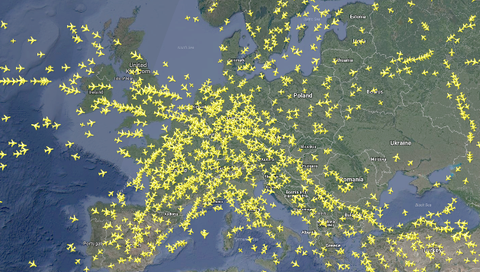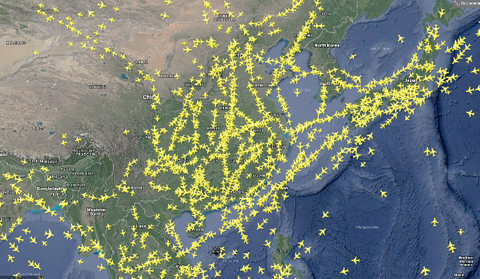UBIQUITOUS
Projektinformationen
- Gefördert durch die DFG
- Kooperation mit der Professur für Ökonometrie und Statistik, insb. im Verkehrswesen
- Projektlaufzeit von 3 Jahren seit August 2019
Ein effizientes Lufttransportsystem erfordert sowohl individuell lokal als auch strömungsbasiert global optimierte Trajektorien der Flugzeuge. Im zivilen Luftverkehr müssen die Trajektorien von Flugzeugen jedoch eine Vielzahl von gesetzlichen Anforderungen erfüllen, wie sie in den Durchführungsbestimmungen für den Flugbetrieb (IR-OPS1) festgelegt sind. So bedingt zum Beispiel der Mindesttreibstoffbedarf für eine bestimmte Flugmission zum Teil Einschränkungen der Flugzeugmasse2. Einschränkungen des lateralen Flugpfades auf der Grundlage weltweit veröffentlichter verfügbarer Wegpunkte gemäß ICAO AIRAC beschränken die Effizienz der Einzeltrajektorie ebenso wie eine begrenzte Anzahl verfügbarer Reiseflugdruckhöhen.
Eine Optimierung hängt ferner vom Netzwerk aus Angebot und Nachfrage, der verfügbaren Flotte, politischen Entscheidungen und der Wettervorhersagefähigkeit als Haupt-Einflussfaktor für die Trajektorienoptimierung ab. Diese Informationen können sehr gut aus ADS-B-Daten (Automatic dependent surveillance-broadcast) extrahiert werden.

Struktur des europäischen Luftverkehrsnetzes.

Struktur des chinesischen Luftverkehrsnetzes.
Dank des ICAO-Mandats für die Installation von ADS-B-Transpondern in Flugzeugen und deren freie zugängliche Datenverfügbarkeit (bspw. über das Opensky Network) sind weltweit offene Trajektorieninformationen wie Position, Höhe, Geschwindigkeit und Vertikalgeschwindigkeit von Verkehrsflugzeugen verfügbar. Diese Daten stellen eine alternative Quelle für die Modellierung der Flugzeugleistung unter Berücksichtigung der Unvorhersehbarkeit der atmosphärischen Zustandsgrößen dar. Die Clusterbildung und Vorhersage von Flugbahnen mit Hilfe von Methoden des maschinellen Lernens unter Berücksichtigung von Umwelteinschränkungen und -unsicherheiten wird bereits weltweit in der Forschung angewandt. Es bleibt jedoch eine Herausforderung, Daten nicht nur mit enormer Menge, sondern auch mit ausreichender Geschwindigkeit zu analysieren
Das Forschungsprojekt "UBIQUITOUS" zielt auf die Untersuchung und Erkennung von Mustern historischer Trajektorien in ADS-B-Daten ab. Mit Hilfe der identifizierten Merkmale wird die Klassifizierung der ATM-Struktur (Air Traffic Management), des Netzwerkes, der Routenstruktur und der Flottenplanung, sowie des Geschwindigkeitsmanagements vorgenommen. Mit einem besseren Verständnis der Verkehrsmuster sollen verbesserte Flugbahnen hinsichtlich operationeller Kosten, Treibstoff, Flugzeit und Klimaauswirkungen unter Verwendung datengesteuerter Ansätze vorgeschlagen werden.
Machinelle Lernmethoden wie K-Means, K-nearest neighbor und Hierarchical Clustering können verwendet werden, um das Clustering einzelner Trajektorien zu untersuchen. Für die Netzwerkstrukturen von Fluggesellschaften werden grafische Netzwerkmodelle zur vergleichenden Analyse von Mustern der Grafik in China und Europa eingesetzt. Neben der deskriptiven Analyse werden traditionelle statistische Modelle wie Regressions- und maschinelle Lernverfahren wie die Support vector machine regression, die Decision tree regression und die Neural network regression verbesserte Trajektorienvorhersagen modellieren.
- Judith Rosenow, Jakub Hospodka, Sébastian Lán, Hartmut Fricke, (2023): Validation of a Contrail Life-Cycle Model in Central Europe, Sustainability 15(11):8669, DOI:10.3390/su15118669
- Judith Rosenow, Hartmut Fricke and Lance Sherry, (2023): Time of the day-dependent impact of Contrail Avoidance Strategies on Airline Delay Costs, Fifteenth USA/Europe Air Traffic Management Research and Development Seminar (ATM2023), Savannah, Georgia
- Judith Rosenow and Hartmut Fricke, (2022): When do Contrails cool the Atmosphere? SESAR Innovation days 2022, Budapest, Hungary
- Gong Chen, Hartmut Fricke, Ostap Okhrin and Judith Rosenow, (2022), Importance of Weather Conditions in a Flight Corridor , Stats 2022, 5 (1), 312-338;https://doi.org/10.3390/stats5010018
- Judith Rosenow, Hartmut Fricke (2019):Condensation Trails in Trajectory OptimizationThirteenth USA/Europe Air Traffic Management Research and Development Seminar (ATM2019), 2019
- Judith Rosenow, Hartmut Fricke (2019):Individual Condensation Trails in Aircraft Trajectory Optimization, Sustainability, Volume 11, Issue 21, DOI: 10.3390/su11216082
- Judith Rosenow, Hartmut Fricke, Tanja Luchkova, Michael Schultz (2018): Minimizing contrail formation by rerouting around dynamic ice-supersaturated regions, Aeronautics and Aerospace Open Access Journal, Volume 2, Issue 3
- Judith Rosenow, Martin Lindner, Hartmut Fricke (2017): Impact of climate costs on airline network and trajectory optimization: a parametric study, CEAS Aeronautical Journal, Volume 8
- Judith Rosenow (2016):Optical Properties of Condensation Trails, Dissertation, Technische Universität Dresden
-
Stanley Förster, Judith Rosenow, Martin Lindner and Hartmut Fricke (2016): A toolchain for optimizing trajectories under real weather conditions and realistic flight performance , Greener Aviation, Brussels
-
Judith Rosenow and Hartmut Fricke (2015): Angle dependent extinction of solar radiation by individual condensation trails, TAC-4 Proceedings, Bad Kohlgrub
-
Michael Kaiser, Judith Rosenow, Hartmut Fricke and Michael Schultz (2012),
Tradeoff between optimum altitude and contrail layer to ensure maximum ecological en-route performance using the enhanced trajectory prediction model (ETPM), Proceedings of the 2nd International Conference on Application and Theory of Automation in Command and Control Systems
-
Judith Rosenow, Michael Kaiser and Hartmut Fricke (2012),
Modeling Contrail life cycles based on highly precise flight profile data of modern aircraft, 5th International Conference on Research in Air Transportation, Berkely
-
Judith Schiller, Michael Kaiser, Michael Schultz, Hartmut Fricke (2010), Impact of ocean currents on contrail formation on global scale, 9th Eurocontrol Innovative ATM Research Workshop, Bretigny, France
Minor Project 2019 Extraction of traffic flows from individual aircraft trajectories

